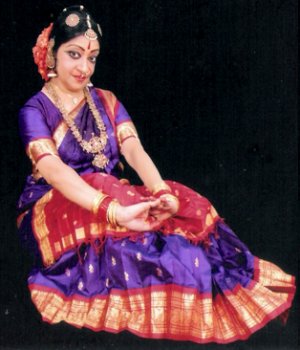
Lakshmi
Mani's outstanding abhinaya
- Shyamala
Krishnamurti, Chennai
e-mail: shyama.krish@rediffmail.com
February 22,
2009
 Sri
Parthasarathy Swami Sabha featured Lakshmi Mani's Kuchipudi dance recital
in their Dance Series, as part of the famed 'arts season' of Chennai. Interestingly,
this was the only Kuchipudi program in this year's line-up of the 109-year-old
Sabha. Lakshmi presented a traditional Kuchipudi 'Margam,' a rarity in
this age of thematic group productions. Not surprisingly, this was thoroughly
relished by the discerning audience present. Sri
Parthasarathy Swami Sabha featured Lakshmi Mani's Kuchipudi dance recital
in their Dance Series, as part of the famed 'arts season' of Chennai. Interestingly,
this was the only Kuchipudi program in this year's line-up of the 109-year-old
Sabha. Lakshmi presented a traditional Kuchipudi 'Margam,' a rarity in
this age of thematic group productions. Not surprisingly, this was thoroughly
relished by the discerning audience present.
Sadly, not
many Kuchipudi dancers adhere to or even know of the 'Margam,' unlike their
Bharatanatyam counterparts, who seem to fare better in this aspect.
Classic examples of this state of affairs include programs where the Tharangam
is relegated to becoming the last item, the ashtapadi and pravesha daruvu
being performed in the first half, while the Sabdam is becoming extinct,
sometimes occurring in the second half, thus making a mockery of the Margam.
There is thus an immediate need for dancers to exercise proper planning
of their repertoire.
Lakshmi Mani
is well respected for her luminous recital of time honoured numbers, as
well as for her own imaginative choreographic inputs to the repertoire.
A superb performer and an intelligent choreographer with a natural eye
for detail, aesthetics and innovation, she has to her credit choreography
of numerous compositions of a galaxy of composers, some totally new to
the Kuchipudi idiom. Feted for her captivating abhinaya, she is regarded
amongst the finest exponents of this dance form. The recital under
notice gave credence to Lakshmi's reputation as a stickler for tradition
and featured mainly her choreographic additions to the classical repertoire.
Starting on
a serene note with the popular Annamacharya composition "Shriman Narayana"
(Bhowli Raga-Adi Thala), Lakshmi paid obeisance to the divine feet of Lord
Venkateshwara, thoughtfully depicting Him as the omnipresent Paramathma,
seen in all of His creations, both animate and inanimate.
She then went
on to perform the Ramayana Sabdam, a traditional number penned by Kasinath
Pandit of Melattur. Set to Mohana Raga and Adi Thala, this piece charmingly
encapsulates the entire Ramayana right from Rama's birth to His coronation.
That traditional items acquire new sheen when performed by seasoned artistes
was a fact that came to one's mind seeing Lakshmi dance, each movement
enhanced by a perfect 'finishing,' a result of her arduous training and
deep rooted passion.
The piece-de-resistance
of the recital was the Tharangam "Paahi Paahi Jaganmohana Krishna." Set
to Ragamalika and Adi Thala, this composition of Narayanateertha describes
the enticing form of Krishna, which bestows supreme bliss to the world.
Lakshmi depicted the motherly affection of Yashoda towards little Krishna,
to the lyric "Nanda Yashoda Nandana." Seemingly transforming herself into
Yashoda, Lakshmi Mani succeeded in bringing a smile to the audience’s lips
when little Krishna rubs butter on the face of the unsuspecting mother
while she feeds him - a hallmark of great abhinaya. She also acquitted
herself extremely well in the contrasting roles of Dusshasana and Draupadi
to the lyric "Deenapalana." Exhibiting prowess and grace, she danced on
the rims of a brass plate to the lyric "Tandavalola Shri Krishna," intertwined
with intricate rhythmic patterns.
The next to
follow was a Kshetrayya padam, "Chaalu Chaalu" in Mukhari Raga and Adi
Thala. The nayika is indignant upon seeing her nayaka with tell-tale marks
on his person and commands him to go away to that 'other' maiden. Lakshmi
gave a very good account of the khandita nayika, complete with sarcasm
and reproach, on sighting Muvvagopala at her doorstep. The program ended
with a Mangalam in praise of Shri Balakrishna.
Lakshmi Mani
was well supported by an excellent team consisting of Sundari (nattuvangam
and compering), Naveena (vocal), Venkat (mridangam), Sikkil Balu (violin),
Ramesh (flute) and Sundararaman (make-up).
|

